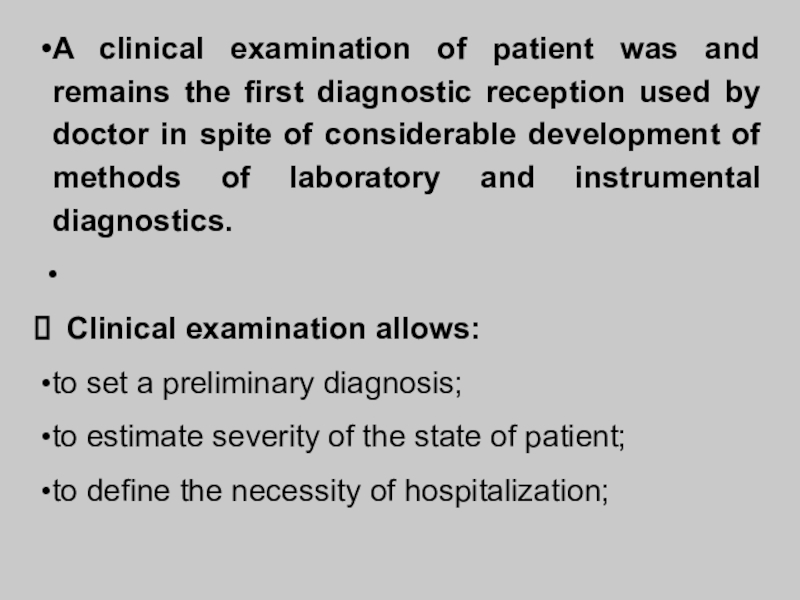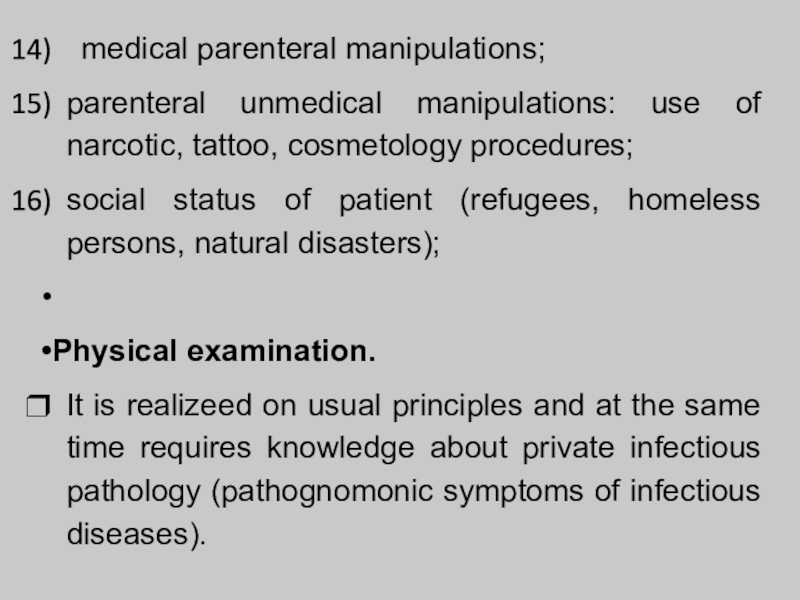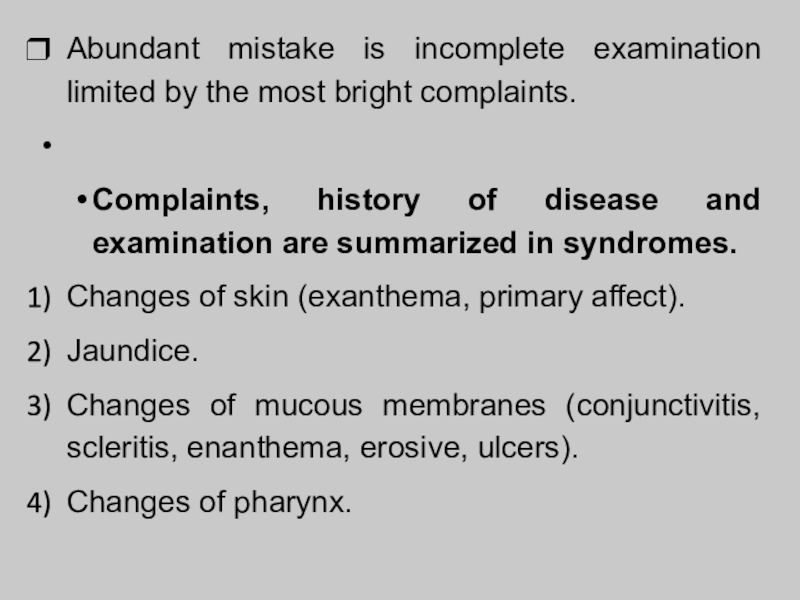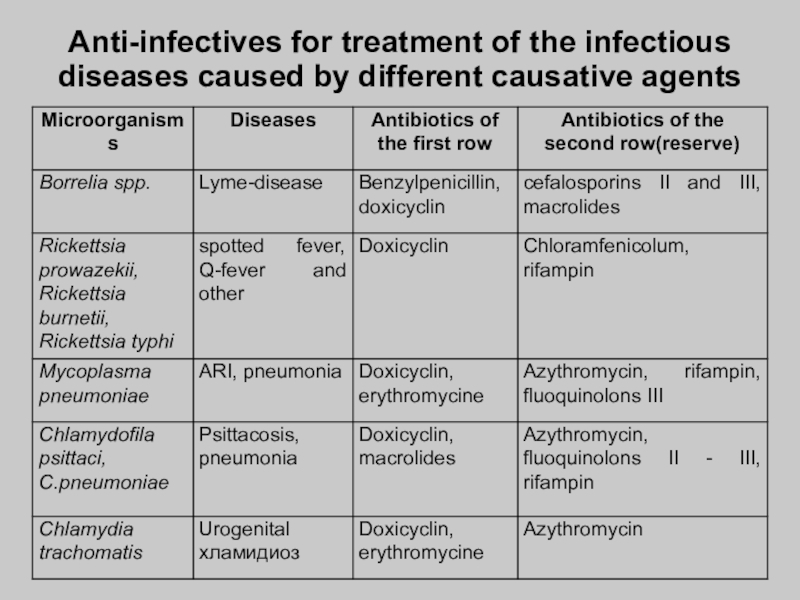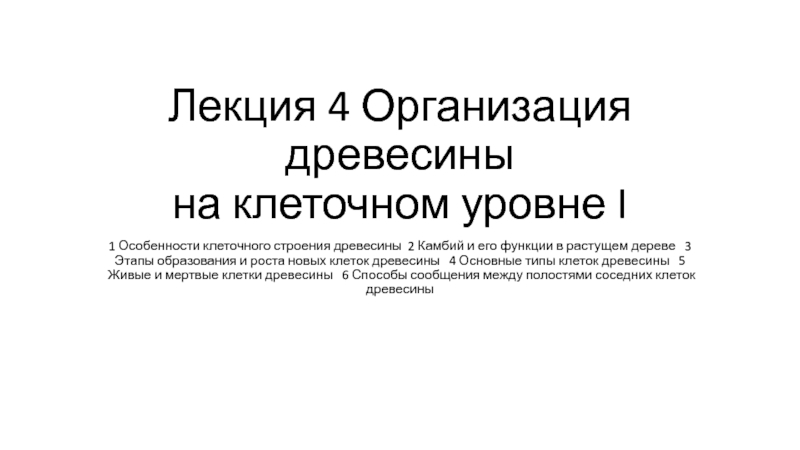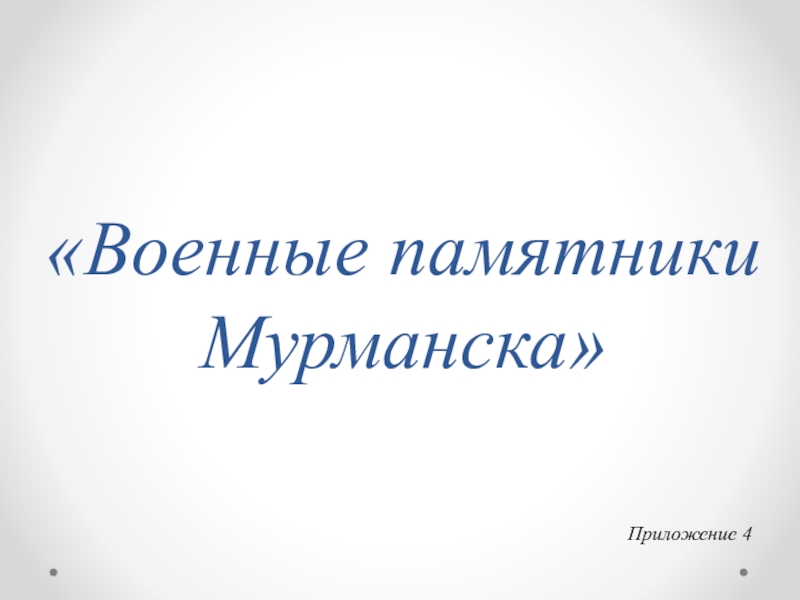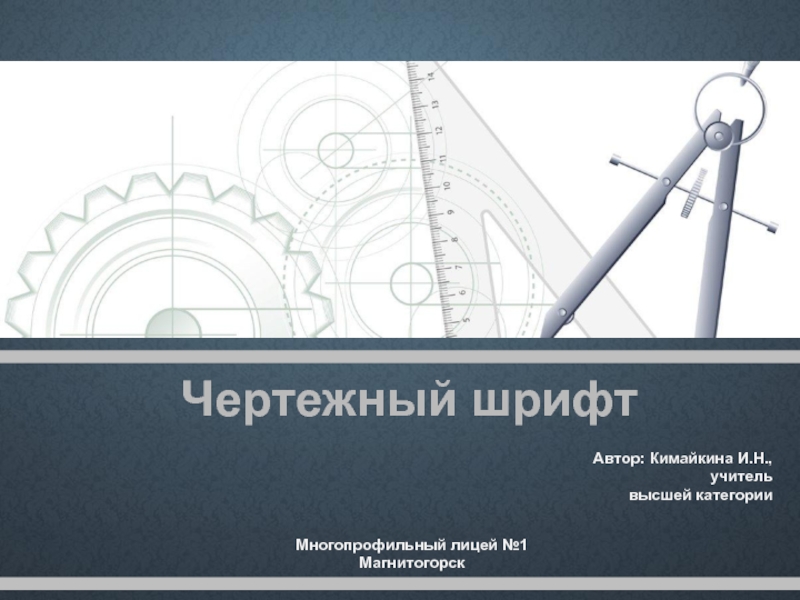Слайд 1PRINCIPLES OF DIAGNOSTIC and TREATMENT OF INFECTIOUS PATIENTS
Слайд 2A clinical examination of patient was and remains the first
diagnostic reception used by doctor in spite of considerable development
of methods of laboratory and instrumental diagnostics.
Clinical examination allows:
to set a preliminary diagnosis;
to estimate severity of the state of patient;
to define the necessity of hospitalization;
Слайд 3to define the necessary volume of laboratory and instrumental researches;
to
form preliminary plan of treatment;
to define the necessity of realization
of epidemic measures at suspicion on infectious disease.
At some infectious diseases (measles, epidemic parotitis, erysipelas, tetanus and other) a diagnosis is set on the basis of clinical manifestation without laboratory confirmation.
Clinical examination is realized in the dynamics of disease that allows to confirm or refute an initial diagnosis, to estimate efficiency of the treatment and to correct plan of laboratory and instrumental examination.
Слайд 4At primary examination at infectious pathology must be suspected.
Complaints.
Patients
can enumerate not all complaints, forgetting part from it (intoxication)
or considering that it do not relate to this disease.
It is necessary to put question about all possible complaints about all systems of organs.
Every complaint must be analysed for times origins, to the dynamics, to reaction on the treatment and other
Слайд 5Complaints must be in detail writtenin in a case report.
At
infectious diseases a diagnosis is usually based on history of
disease and epidemiology anamnesis.
Next signs must be taken to the history of disease.
Sharpness of beginning of disease (day, hour, appearance of the first symptoms).
Sequence and terms of appearance of symptoms.
Periods of development of disease.
Слайд 6Dynamics of development of symptoms.
Efficiency of any treatment.
Doses and
duration of drug reception.
Possible change of natural duration of
disease under reception of treatment.
Analysis of laboratory and instrumental study.
It is necessary to distinguish leading clinical syndromes and/or separate the signs of damage of different organs and systems.
It is important to know the state of patient before disease.
Слайд 7History of life.
Birth-place and all subsequent places of inhabitation.
Features of
life, predisposition, professional negative factors.
Data about the carried and present
chronic diseases
Possibility of the inherited factors.
Allergic anamnesis.
Information about the realizeed prophylactic inoculations.
Слайд 8Epidemiology anamnesis.
Infectious diseases is related to realization of epidemiologic process:
«source of infection − mechanism of transmission − sensitive organism».
The correct epidemiology data allows to define directions of diagnostic search.
Contact with source of infection, possibility of different mechanisms of transmission. Spectrum of causative agents of infectious diseases which patient could be met.
Taking into account of regional infectious pathology.
Слайд 9«Social portrait» of patient.
Traveling
Features of place of residence of
patient (apartment or private house, hostel, barrack), presence of the
centralized water-supply and sewage system;
who lives with a patient, guests from other regions;
character of feeding of patient : at home, at work, places of public food consumption
use the food from other regions;
Слайд 10use of food out of organized places, thermally not treated,
not washed vegetables, fruit etc.;
use of from open and unverified
sourses;
stay in the organized collective;
occupation, contacts with people, children, animals and birds;
possible contacts with sick persons;
absence of information about contacts with infectious diseases does not eliminate infectious pathology;
hunting, fishing, tourism;
sexual contacts, methods of contraception;
Слайд 11medical parenteral manipulations;
parenteral unmedical manipulations: use of narcotic, tattoo, cosmetology
procedures;
social status of patient (refugees, homeless persons, natural disasters);
Physical examination.
It
is realizeed on usual principles and at the same time requires knowledge about private infectious pathology (pathognomonic symptoms of infectious diseases).
Слайд 12Abundant mistake is incomplete examination limited by the most bright
complaints.
Complaints, history of disease and examination are summarized in syndromes.
Changes
of skin (exanthema, primary affect).
Jaundice.
Changes of mucous membranes (conjunctivitis, scleritis, enanthema, erosive, ulcers).
Changes of pharynx.
Слайд 13Changes of fatty hypoderm (edema, induration).
Changes of muscles.
Changes lymphatic nodes
(lymphadenopathy, bubo).
Arthral syndrome.
Catarrhal-respiratory syndrome (rhinitis, laryngitis, tracheitis, bronchitis, bronchiolitis), pneumonia,
respiratory insufficiency.
Myocarditis, heart failure (insufficiency of circulation of blood).
Слайд 14Changes of tongue («raspberry», «strawberry», «pilose», leucoplakia and other).
Syndrome of
damage of gastrointestinal tract.
Hepatitis, hepatolienal syndrome,.
Encephalopathy, meningeal syndrome, focal damage
of CNS.
Cholestasis.
Urethritis, cystitis, pyelonephritis, nephrosonephritis, acute kidney insufficiency.
Слайд 15Syndrome of intoxication.
Shock.
Other.
In a preliminary diagnosis necessarily to specify:
severity of
the state of patient,
clinical form of disease in accordance
with the generally accepted classification,
complications and concomitant diseases (risk factors).
syndrome of critical condition.
Слайд 19A final diagnosis has nosology form of disease.
Nosology diagnosis includes
causative agent.
Main task of treatment is to affect causative
agent or its toxin that must result in recovery of infectious patient.
The plan of examination must
be concrete,
be the most informative,
be minimal invasive
take into account tolerance of patient.
Слайд 20The plan of examination must be directed:
on a main disease;
on
complication;
on the prognosis of disease;
on a critical condition;
on concomitant diseases
Слайд 21Directions of the plan of examination are:
1. General:
CBC;
analysis of urine;
analysis
of feces;
chest X-ray.
2. Examination on HIV-infection and syphilis
Слайд 223. Specific confirmation of preliminary diagnosis :
bacteriological;
virologic;
serologic;
allergic and other
4. Specific
instrumental, biochemical, roentgenologic and other researches corresponding clinical indication
Слайд 23Bacteriologic examinations include bacteriologic examination of blood, defecating, urine, palatal
amygdales, the sputum and other usually before etiotropic treatment.
Serologic researches
can be realizeed in pair serums (in 7-10 days).
The negative results of researches do not always except clinical diagnosis
Слайд 24The methods of etiologic diagnostics have the special value at
their timely application and assist the correct choice of etiotropic
treatment (sensitiveness to antimicrobial drugs).
A microscopy of Gram-stained smears of blood, sputum, CSF, urine and exsudates has some value for the start therapy.
Express-test acquired important role due to fast visual estimation of result.
Слайд 25Microscopy is used for finding of causative agent in the
pathological material taken from a patient. At most cases it
does not allow to put a final diagnosis (except some parasitosises).
Advantage is rapid discovery of causative agents in pathological material.
Слайд 26 film preparation from nose and throat for immunofluorescent microscopy.
smear from
pharynx selection of viruses at a flu, measles, german measles,
chicken-pox and other viral infections. Material is sent in a laboratory for realization virologic, immunofluorescent, PCR and other researches.
Слайд 27Thick drop and thin smear of blood for microscopic diagnostics
of malaria is dried out and sent in laboratory.
Microscopic research
of CSF allows to define character of cytosis and suppose microorganism.
The microscopy of feces allows to educe characteristic pathological admixtures, presence of hemocytes and to discover protozoo.
Слайд 28 Bacteriological method.
It is used for selection of causative microbes-agents
in a clean culture on artificial nutrient medium or at
laboratory animals.
The selection of pathogenic microorganism at presence of clinical manifestation of disease allows to put a final diagnosis.
A sensitiveness to the antibiotics can be determined.
It requires plenty of time.
Слайд 29Bacteriologic examination on artificial nutrient mediums is best of all
to produce immediately after the taking of material.
The dispatch
of material in a laboratory is done as quick as possible (not later than 2 hours from the moment of taking).
Automatic microbiological systems are presently created.
Слайд 30Order to laboratory for tests of taken from infectious patient
material must contain:
Name of material and research aim.
Department.
Name of patient.
Date
of beginning of disease.
Date of taking of material.
Supposed clinical diagnosis.
Signature of doctor.
Слайд 31Additional researches.
Lavage of stomach with a curative and diagnostic aim.
Rectoscopy.
Sternal
puncture.
Taking of material from superficial wounds.
USI, NT, CT, X-ray, gastroscopy,
colonoscopy., ECG.
Biopsy of lymphnode etc.
Слайд 32
PRINCIPLES OF TREATMENT OF INFECTIOUS PATIENTS
A feeding at infectious diseases
is one of basic constituents of parts of complex therapy.
Curative feeding (dietotherapia) is application with the curative or prophylactic aim of the specially made food rations and diets for patients with acute and chronic infectious diseases.
Слайд 33Basic principles of feed of infectious patients.
Only valuable and balanced
feed.
Taking into account intoxication, fever, change of metabolism etc.
Main part
of food is given in the clock of decline of temperature.
It is not necessary to overfeed a patient or aspire to very rapid renewal of mass of body.
At severe duration and unconscious state of patients enteral tube feeding is used.
Diets must have 2200-2500 kkal with a subsequent increase to 3000 kkal per day.
The special attention must be spared to vitamins.
Слайд 34PRINCIPLES OF ANTIBACTERIAL THERAPY OF INFECTIOUS PATIENTS
High-pathogenic stamms of causative
agents resistant to antibacterial drugs appear in the conditions of
wideuse of etiotropic drugs.
The number of people with the decreased resistance of macroorganism and secondary immunodeficit increases.
Presently successes of microbiology allow to choose antibiotics with the expressed antibacterial action and "narrow" action, that reduces the danger of dysbiosis.
Слайд 35Cost can have influence at choice of antibiotic.
The choice of
drugs is based on etiology of disease, severity and period
of disease.
Chemotherapy is antimicrobial, antiviral, antiparasitogenic treatment by chemical substances
Antibioticotherapy is treatment by natural antibiotic producted by microorganisms; many modern antibiotics are semisynthetic.
Слайд 36Classification of antibiotics.
By the mechanism of action:
inhibitors of synthesis of
cellular wall of microorganism (penicillins, cefalosporins, vancomycin and other);
antibiotics defiat
molecular organization functions of cellular membranes (polymixin, Levorinum, amphotericin and other);
antibiotics depressing the synthesis of albumen and nucleic acids, in particular at the level of ribosomes (chloramphenicol, Tetracyclins, macrolides, lincomycin, aminoglycosides) and inhibitors of RNA-polymerase (rifampin)
Слайд 37By chemical structure:
1) betalactams (penicillins, cefalosporins of and other),
2) aminoglycosides,
3) chloramphenicol,
4) Tetracyclinums,
5) fusidin,
6) rifampins,
Слайд 387) polimyxins,
8) polyenes,
9) macrolides
10) other
By the type
of affecting microbal cell:
Bactericidal (penicillins, cefalosporins, aminoglycosides, rifampin, polimyxin and
other);
Bacteriostatic (macrolides, Tetracyclinums, lincomycin, chloramphenicol and other).
Слайд 39By the spectrum of antimicrobial action :
Gram-positive bacteria and cocci:
biosynthetic penicillins, lincomycin, vancomycin, fusidin.
Gram-negative bacteria : aztreonam, polimyxin.
Wide spectrum:
aminopenicillins (ampicillin), ureidopenicillins, cefalosporins, aminoglycosides, chloramphenicol, Tetracyclinums, macrolides, carbapenems.
Antiphthisic antibiotics (streptomycin, rifampin).
Antifungal antibiotics (Levorinum, amphotericin B, ketoconazole and other).
Слайд 40A pharmacodynamics and pharmakokinetics of drug, individual features of patient
(age, state of immunity, concomitant diseases and other) are necessary
to take into account.
Efficiency of treatment by antibiotics is determined by next factors:
Detection of causative agent and its sensitiveness to the antibiotics;
Use of most active and less toxic drug;
Слайд 41Determination of optimal dose and method of introduction of antibiotic;
Knowledge
about possible side reactions on antibiotic;
Distribution in organs and tissues,
ability to penetrate physiological and pathological barriers of organism
Use of combination of drugs with the purpose of expansion of spectrum of action and/or strengthening of antimicrobial effect.
Слайд 42Anti-infectives for treatment of the infectious diseases caused by gram-positive
and gram-negative cocci
Слайд 43Anti-infectives for treatment of the infectious diseases caused by gram-positive
and gram-negative bacteria
Слайд 47Anti-infectives for treatment of the infectious diseases caused by different
causative agents
Слайд 48Quite often in clinical practice infectiologists use combined treatment by
antibiotics. Basic indications are:
mixed infections;
preventing of development of stability to
the antibiotic;
strengthening of antibacterial effect;
insufficient sensitiveness of causative agents to antibiotics.
Слайд 49The next variants of co-operation of antibiotics are possible:
indifferent action
- no change of effect of each antimicrobial drug (chloramphenicol
+ erythromycine);
additive action - the antibacterial effect of the applied drugs is equal to the sum of action of each of them individually, independently one from other;
synergistic action - the effect of joint application of two antibiotics exceeds simple sum actions of every drug individually (betalactams + aminoglycosides);
antagonistic action - effect at combination of drugs is below than effect each individually (betalactams + Tetracyclinums).
Слайд 50Main problems of etiotropic therapy.
Expansion of spectrum of pathogenic
flora, viral-bacterial associations and other).
Increase of number of resistant
stamms
Appearance of new data about the pharmacodynamics depending on age, concomitant diseases, complications, localization of damage and other.
Growth of amount of complications and side effects;
appreciation of cost.
Слайд 51The possible ways of decision of the indicated problems:
Standardization of
charts of initial (starting) empiric therapy.
Optimization of ways of introduction
of etiotropic drugs.
Combined application of etiotropic drugs.
Combination with nosotropic drugs.
Account of biocomprehensibility and mode of use.
Слайд 52PRINCIPLES OF ANTIVIRAL THERAPY OF INFECTIOUS PATIENTS
The viral diseases of
people become more actual.
Antiviral therapy, unlike antibacterial, possesses the less
arsenal of curative drugs considerably.
Antiviral therapy is not wideuse practicaly.
Слайд 53Drugs must have antiviral action at the minimum damaging of
cells of macroorganism.
The methods of application of antiviral drugs are
limited by insufficient knowledge of their pharmakokinetics.
Efficiency depends on protective forces of organism and state of immunity;
Слайд 54For practical medicine the methods of determination of sensitiveness of
viruses are not accessible.
There is no single classification of antiviral
drugs.

